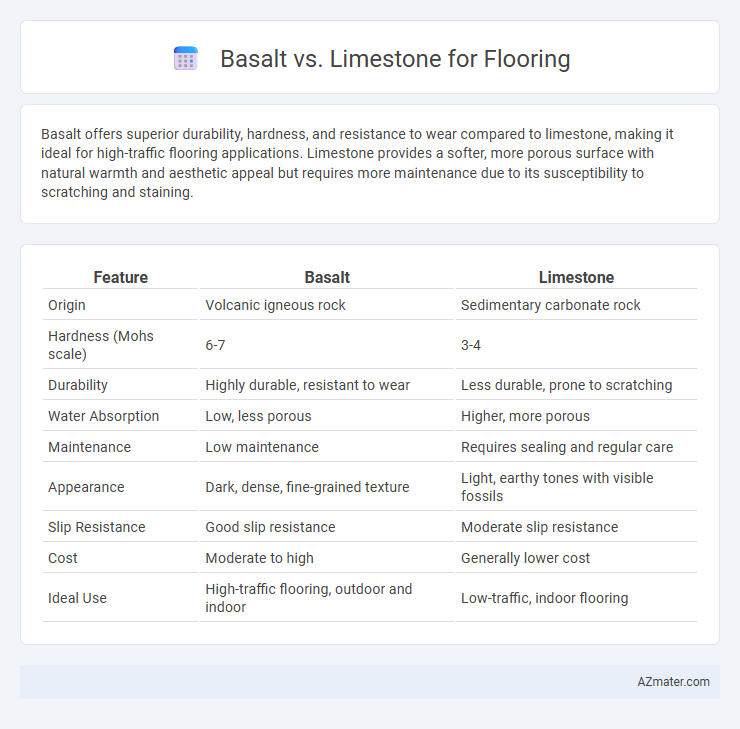Basalt offers superior durability, hardness, and resistance to wear compared to limestone, making it ideal for high-traffic flooring applications. Limestone provides a softer, more porous surface with natural warmth and aesthetic appeal but requires more maintenance due to its susceptibility to scratching and staining.
Table of Comparison
| Feature | Basalt | Limestone |
|---|---|---|
| Origin | Volcanic igneous rock | Sedimentary carbonate rock |
| Hardness (Mohs scale) | 6-7 | 3-4 |
| Durability | Highly durable, resistant to wear | Less durable, prone to scratching |
| Water Absorption | Low, less porous | Higher, more porous |
| Maintenance | Low maintenance | Requires sealing and regular care |
| Appearance | Dark, dense, fine-grained texture | Light, earthy tones with visible fossils |
| Slip Resistance | Good slip resistance | Moderate slip resistance |
| Cost | Moderate to high | Generally lower cost |
| Ideal Use | High-traffic flooring, outdoor and indoor | Low-traffic, indoor flooring |
Introduction to Basalt and Limestone Flooring
Basalt flooring offers exceptional durability and a sleek, dark appearance derived from volcanic rock, making it ideal for high-traffic areas with a modern aesthetic. Limestone flooring, formed from sedimentary carbonate minerals, provides a softer, porous surface with natural warm hues and unique textures, enhancing traditional or rustic interiors. Both materials require proper sealing to maintain longevity and resist moisture, with basalt boasting higher hardness and limestone offering greater versatility in design.
Key Characteristics of Basalt Flooring
Basalt flooring stands out for its exceptional durability, natural resistance to heat, and fine-grained texture that offers a sleek, modern appearance. Its dense composition makes it highly resistant to wear, scratch, and stains, ideal for high-traffic areas. The stone's dark, consistent color tones provide a unique aesthetic appeal compared to lighter, more porous limestone flooring.
Key Characteristics of Limestone Flooring
Limestone flooring features a soft, porous texture with natural variations in color, ranging from cream to beige, making each tile unique and ideal for warm, inviting interiors. Its durability is moderate compared to basalt, requiring regular sealing to prevent staining and moisture damage while offering a comfortable, slip-resistant surface. Limestone's matte finish enhances its rustic appearance, contributing to a timeless elegance that complements both traditional and contemporary design styles.
Aesthetic Appeal: Basalt vs Limestone
Basalt flooring offers a sleek, modern aesthetic with its dark, uniform color and fine-grained texture, creating a contemporary and elegant ambiance. Limestone provides a warm, natural look characterized by earthy tones and subtle variations, adding rustic charm and timeless beauty to interior spaces. Both stones enhance visual appeal but cater to different design preferences: basalt suits minimalist styles, while limestone complements traditional and Mediterranean-inspired interiors.
Durability and Strength Comparison
Basalt flooring offers exceptional durability due to its dense, fine-grained structure, making it highly resistant to wear, scratches, and heavy foot traffic compared to limestone. Limestone, while visually appealing with its softer texture, is more porous and prone to chipping and erosion over time, reducing its long-term strength. For high-traffic areas, basalt provides superior structural integrity and longevity, ensuring a more resilient flooring solution.
Maintenance Requirements for Basalt and Limestone
Basalt flooring requires minimal maintenance due to its dense, non-porous surface that resists stains and scratches, making it ideal for high-traffic areas. Limestone, being more porous and softer, demands regular sealing and gentle cleaning to prevent staining and surface etching from acidic substances. Both materials benefit from routine sweeping and mopping, but basalt's durability significantly reduces long-term upkeep compared to limestone.
Slip Resistance and Safety Factors
Basalt flooring offers superior slip resistance due to its naturally rough texture and high-density composition, making it ideal for wet or high-traffic areas where safety is paramount. Limestone, while aesthetically pleasing with its smooth, fine-grained surface, tends to be more slippery when wet because of its softer mineral structure, requiring additional treatments or coatings to enhance traction. Choosing basalt enhances safety factors effectively, reducing slip hazards and providing durable, non-slip flooring solutions in both residential and commercial environments.
Installation Considerations
Basalt flooring requires professional installation due to its dense, hard composition, often necessitating specialized cutting tools and adhesives for proper adherence. Limestone offers easier handling with lighter weight and softer texture, allowing for quicker cutting and less intensive labor during installation. Moisture resistance is higher in basalt, making it suitable for areas prone to humidity, whereas limestone may require sealing to prevent water damage over time.
Cost Analysis: Basalt vs Limestone Flooring
Basalt flooring typically costs between $7 and $15 per square foot, reflecting its durability and dense composition, whereas limestone ranges from $5 to $12 per square foot due to its softer texture and easier quarrying process. Installation costs for basalt may be higher because of its hardness, requiring specialized tools and increased labor time, while limestone's relative softness allows for quicker and more cost-effective installation. Long-term maintenance expenses also differ, with basalt offering lower upkeep costs due to higher resistance to staining and wear, compared to limestone, which may require regular sealing and careful cleaning to prevent damage.
Ideal Applications and Recommendations
Basalt offers exceptional durability and resistance to wear, making it ideal for high-traffic residential and commercial flooring, especially in areas prone to moisture due to its low porosity. Limestone provides a softer, more elegant aesthetic best suited for low-traffic indoor spaces like living rooms or bedrooms, where its natural warmth complements traditional and rustic designs but requires regular sealing to prevent staining. For optimal flooring choices, select basalt for durability and moisture-prone environments, while limestone is recommended for aesthetic appeal in controlled, low-traffic interiors.

Infographic: Basalt vs Limestone for Flooring
 azmater.com
azmater.com